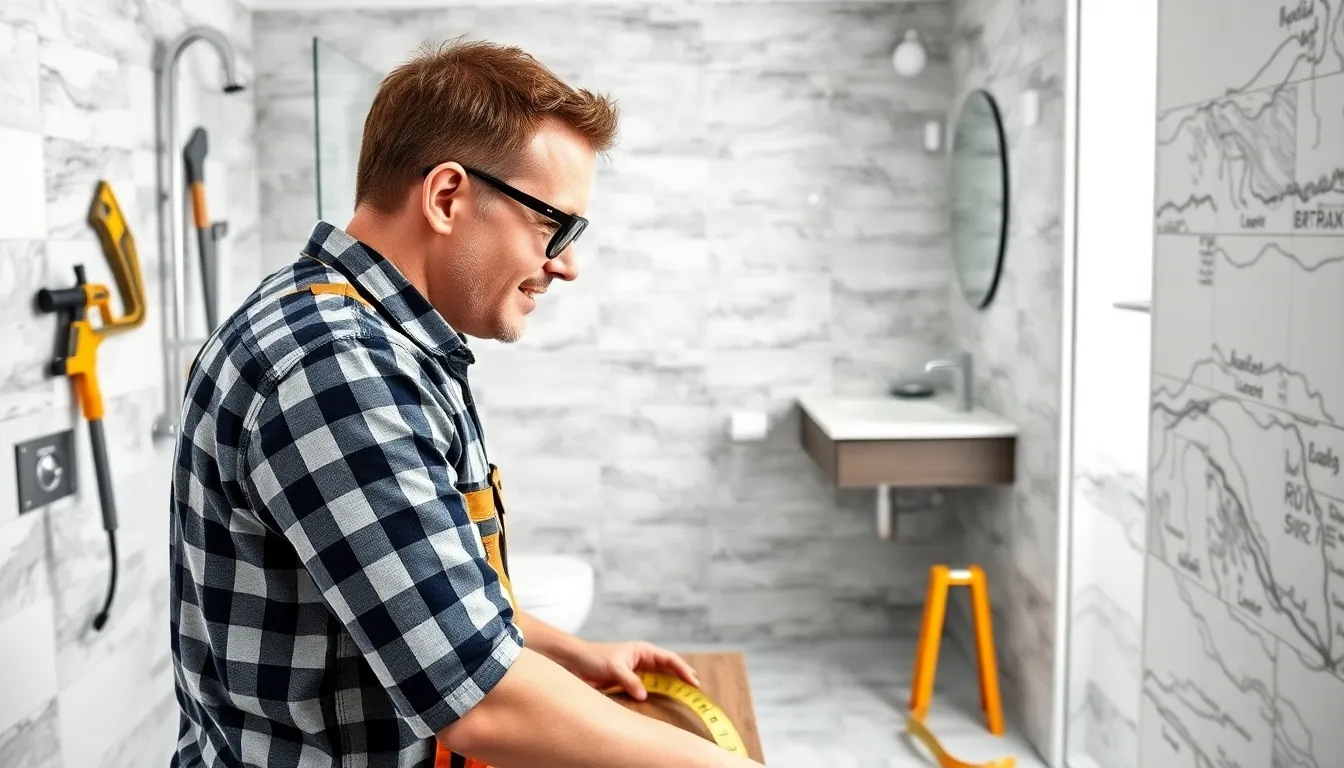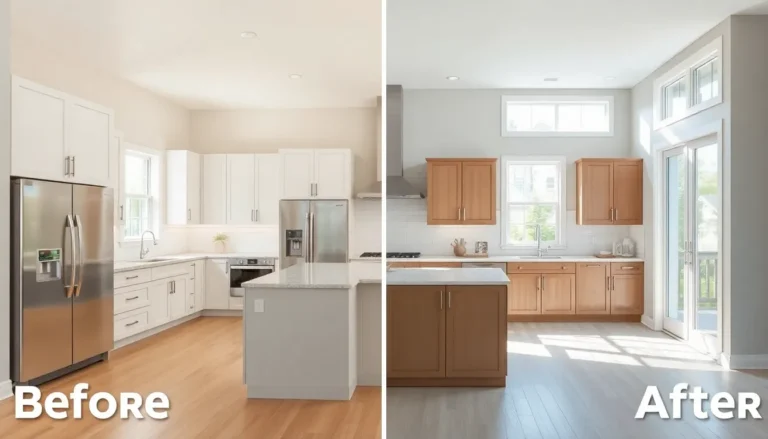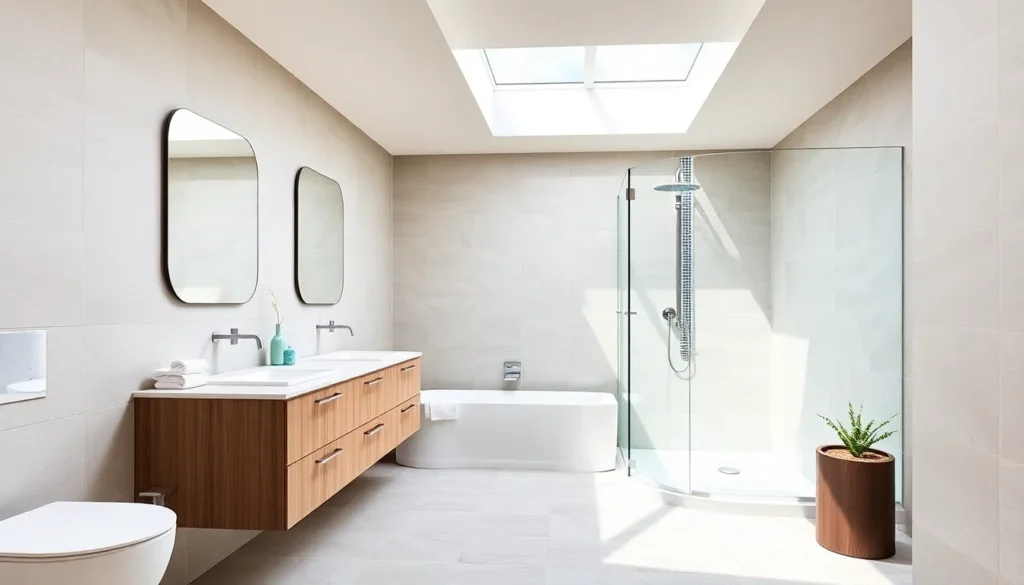Table of Contents
ToggleWhen it comes to transforming that tired bathroom into a personal oasis, the terms “remodel” and “renovation” often get tossed around like confetti at a parade. But what’s the real difference? Is it a simple facelift or a full-blown makeover? Understanding these two concepts can save a homeowner from making costly mistakes or ending up with a toilet that’s more of an eyesore than a throne.
Understanding Bathroom Remodel Vs Renovation
Understanding the difference between a bathroom remodel and renovation clarifies the specific goals for a project. Both terms describe changes to a bathroom but focus on different aspects.
Definition of Bathroom Remodel
A bathroom remodel involves altering the layout and design of the space, often including structural changes. Homeowners might replace fixtures, move walls, or change the flooring. This process enhances the overall functionality and aesthetic appeal. Examples of a remodel include adding a double vanity or installing a walk-in shower. Major updates often require the input of contractors and design professionals.
Definition of Bathroom Renovation
Bathroom renovation focuses on restoring existing features without altering the structure. Renovations typically involve cosmetic changes, such as repainting, replacing tiles, or upgrading fixtures. Homeowners may seek to refresh the space while maintaining the original layout. Examples of renovation include changing outdated cabinetry or refreshing a bathtub. This approach often offers a cost-effective way to improve appearance while minimizing extensive work.
Key Differences Between Remodel and Renovation

Understanding the difference between remodel and renovation helps homeowners make informed decisions regarding their bathroom projects. Each process serves distinct objectives, impacting how a space transforms.
Structural Changes
Remodeling a bathroom involves significant structural changes. Homeowners may alter the layout by moving fixtures or adding new elements like walls or windows. For example, plans for a double vanity or a walk-in shower typically require removing existing installations. These structural alterations enhance both functionality and spatial flow, creating a completely new environment. Additionally, permits may be necessary for major structural changes, ensuring compliance with building codes.
Aesthetic Changes
Renovation focuses on aesthetic changes within the existing layout. Actions such as repainting, retiling, or updating fixtures fall under this category. Homeowners can refresh the bathroom’s look without altering its structure. Minor updates, like changing hardware or swapping out light fixtures, provide a cost-effective way to modernize the space. Overall, renovations invigorate visually and can increase property value with minimal disruption to the existing design.
Cost Considerations
Evaluating costs remains essential when deciding between a bathroom remodel and a renovation. Understanding these financial aspects allows homeowners to make informed choices.
Budgeting for Remodels
Budgeting for a remodel often requires a larger investment. Changes like moving plumbing fixtures or adding custom cabinetry can significantly increase expenses. On average, a bathroom remodel could range from $15,000 to $30,000 depending on scope. Homeowners might allocate funds for permits or structural changes, which also impact total costs. Labor costs represent a considerable portion, typically accounting for 20% to 35% of the overall budget. Collaborating closely with a contractor helps refine budget estimates while ensuring the project remains within financial limits.
Budgeting for Renovations
Budgeting for renovations generally requires a smaller financial commitment. Average costs usually fall between $5,000 and $15,000, primarily focused on aesthetic updates. Homeowners can replace fixtures, paint walls, or add new tile without substantial alterations to the budget. Since renovations do not necessitate permits, expenses stay lower due to fewer regulatory fees. Prioritizing high-impact improvements, such as new lighting, can provide a fresh look without a hefty price tag. By clearly defining goals and engaging with professionals, homeowners achieve aesthetic results while adhering to budget constraints.
Timeframes for Each Process
Timeframes for bathroom remodels and renovations vary significantly. Understanding these differences aids in effective project planning.
Typical Duration of a Remodel
Bathroom remodels usually take longer due to their complexity. Expect remodels to last from six weeks to three months. This timeframe allows for structural changes, such as plumbing adjustments or layout modifications. Design decisions can extend the duration as well. Contractors often require time for permits and inspections, further influencing the schedule. Factors like project size and contractor availability may also affect timelines.
Typical Duration of a Renovation
Renovations generally complete within shorter periods, typically ranging from one to four weeks. Cosmetic updates are quicker, as they usually do not require structural changes. Tasks such as painting, tiling, or fixture replacements can progress swiftly. Homeowners can often continue using their bathrooms during minor renovations. Seasonal demand for contractors may impact scheduling, so planning in advance ensures smoother project execution.
Popular Trends in Bathroom Remodeling
Spa-like features enhance relaxation in modern bathrooms. Homeowners increasingly integrate freestanding tubs, rainfall showerheads, and heated floors. Accessibility also gains attention, with curbless showers and grab bars designed for all ages.
Sustainable materials form another significant trend. Bamboo flooring and recycled glass tiles appeal for their aesthetic and eco-friendly properties. Such choices not only conserve resources but also elevate the space’s style.
Smart technology finds its way into bathroom design. Motion sensor faucets, smart mirrors, and digital thermostats add convenience and efficiency. These innovations not only elevate functionality but also create a modern ambiance.
Open layouts are popular among homeowners who value space and light. Removing non-load-bearing walls creates a roomy feel, allowing for better movement and accessibility. Natural light sources, such as skylights, further enhance the overall experience.
Neutral color palettes dominate bathroom remodeling. Shades of gray, white, and beige produce a serene atmosphere. Homeowners often incorporate bold accent tiles or fixtures to introduce personality without overwhelming the design.
Adding storage solutions can transform bathroom organization. Wall-mounted shelves, under-sink cabinets, and built-in niches help maintain a clutter-free environment. Thoughtful storage not only maximizes space but also contributes to the bathroom’s overall aesthetic.
Custom vanities remain a focal point in bathroom design. Personalized cabinetry, available in various finishes and sizes, offers functionality tailored to individual needs. This bespoke approach allows homeowners to match the vanity style to their preferences seamlessly.
Understanding the differences between bathroom remodels and renovations is crucial for homeowners looking to enhance their space. By recognizing the unique benefits and costs associated with each option, they can make informed decisions that align with their goals and budget.
Whether opting for a full remodel to create a custom oasis or a simple renovation to refresh the existing design, careful planning and collaboration with professionals can lead to satisfying results. With the right approach, transforming a bathroom can not only elevate functionality and aesthetics but also increase property value.





